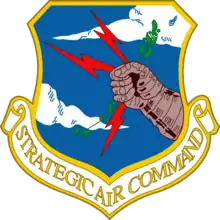346th Test Squadron
The 346th Test Squadron is a United States Air Force unit assigned to the 318th Cyberspace Operations Group at Joint Base San Antonio–Lackland, Texas. The squadron tests military cyberspace operation systems.
346th Test Squadron
 | |
|---|---|
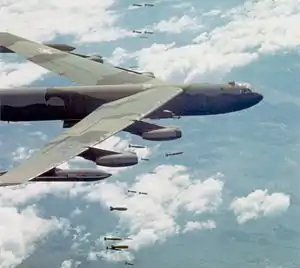 A B-52D Stratofortress dropping bombs over Vietnam[note 1] | |
| Active | 1942–1945; 1947–1949; 1953–1974; 1993–1995; 2000–present |
| Country | |
| Branch | |
| Role | System Testing |
| Size | 120 personnel[1] |
| Part of | Air Force Space Command |
| Garrison/HQ | Joint Base San Antonio–Lackland |
| Engagements | Mediterranean Theater of Operations |
| Decorations | Distinguished Unit Citation Air Force Outstanding Unit Award with Combat "V" Device Air Force Outstanding Unit Award Air Force Organizational Excellence Award Vietnam Cross of Gallantry with Palm |
| Insignia | |
| 346th Test Squadron emblem (approved 7 November 2000)[2] | 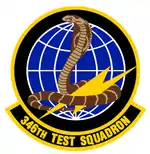 |
| 346th Bombardment Squadron emblem (c. 1963) | 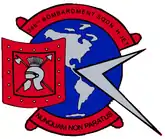 |
| 346th Bombardment Squadron emblem (approved 18 February 1944)[3] | 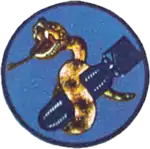 |
The squadron was first activated as the 346th Bombardment Squadron in 1942. After training in the United States, it moved to the Mediterranean Theater of Operations, where it earned two Distinguished Unit Citations in operations against the Axis Powers. After V-E Day, the squadron remained in Italy until November 1945, when it was inactivated. The squadron was activated in the reserves from 1947 to 1949, but does not appear to have been fully manned or equipped.
In 1953, the squadron was activated as the 346th Strategic Reconnaissance Squadron as part of Strategic Air Command. It returned to the bombardment mission two years later, and served in this role until inactivating in 1974. Although the squadron remained in the United States except for one deployment in the 1950s, during the Vietnam War it deployed its aircrews and Boeing B-52 Stratofortresses to Southeast Asia. For extended periods, all squadron personnel and equipment were deployed.
The squadron was activated in 1993 as the 346th Test and Evaluation Squadron and performed operational testing and evaluation until inactivating in 1995. It was activated in its current role in 2000.
Mission
The squadron mission is to conduct independent operational tests and evaluations, emissions security tests, and other specialized tests of cyberspace capabilities. It operates Air Force Space Command’s cyber test & training range. The 346th's 120 personnel include 50 active duty airmen, 30 Department of Defense civilian employees and 40 contractors.[1]
The 346th conducts operational tests for components of weapons systems, equipment, or software to determine its operational effectiveness and suitability. It identifies unexpected critical system performance issues that might affect system combat effectiveness before system fielding.[1]
History
World War II
Established in early 1942 as a Boeing B-17 Flying Fortress heavy bombardment squadron; trained under Second Air Force first in the Pacific Northwest, but the poor flying weather in the northwest forced a relocation to the Midwest for the second and third phases of training.
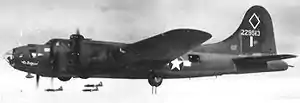
After completion of training, the 346th departed for the Mediterranean Theater of Operations in Algeria, where the ground echelon went by ship from New York City to Marrakech, Morocco; the air echelon flying to Morrison Field, Florida, then along the South Atlantic Route to Navarin Airfield, Algeria, where the ground and air echelons of the squadron were reunited in late February 1943. Assigned to Twelfth Air Force, the squadron engaged in combat operations in support of American ground forces in Algeria and Tunisia during the 1943 North African campaign.
Helped force the capitulation of Pantelleria Island in June 1943. Bombed in preparation for and in support of the invasions of Sicily and southern Italy in the summer and fall of 1943. Was reassigned to the new Fifteenth Air Force in October 1943 and until the German capitulation in May 1945; engaged in strategic bombardment of enemy targets in Italy, France, Germany, Czechoslovakia, Austria, Hungary, Romania, Bulgaria, Yugoslavia, and Greece, attacking oil refineries, marshaling yards, aircraft factories, and other strategic objectives. Squadron was demobilized in Italy in late 1945; inactivated in November.
Air Force reserve
Activated in the reserves in 1947, however unit never equipped or manned. Inactivated in 1949 due to budget restraints.
Strategic Air Command
The squadron was reactivated in January 1953 at Fairchild Air Force Base, Washington[2] when the 111th Strategic Reconnaissance Wing, an Air National Guard unit that had been mobilized for the Korean War, was returned to state control. The squadron assumed the mission, personnel, and Convair RB-36 Peacemaker strategic reconnaissance aircraft of the 111th Wing's 103d Strategic Reconnaissance Squadron, which returned to the Maryland Air National Guard. Engaged in worldwide strategic bombardment training and stood nuclear alert until 1956 when the B-36 was retired.
Re-equipped with B-52 Stratofortresses and continued training and nuclear alert status. Deployed personnel and aircraft to Pacific during Vietnam War, engaging in Operation Arc Light combat missions over North Vietnam; also deployed personnel and aircraft to Thailand flying out of U-Tapao Royal Thai Naval Airfield for combat missions over Cambodia and Laos. Inactivated in 1974 with the inactivation of parent 99th Bombardment Wing and transfer of Westover Air Force Base to the Air Force Reserve.
Test operations
The 346th's mission changed when it became the 346th Test and Evaluation Squadron in June 1993 and was activated under the 99th Test Group at Ellsworth Air Force Base, South Dakota. For the next two years, it performed operational test and evaluation for Air Combat Command systems. The squadron and 99th Group were inactivated at Ellsworth in 1995 as ACC centralized its operational test and evaluation under the 53d Wing at Eglin Air Force Base, Florida.[2]
The squadron was again activated at Kelly Air Force Base, Texas in August 2000 as the 346th Test Squadron and assigned to the 318th Information Operations Group.[2] As part of the unit's focus on cyber defense, in 2014 it began participating in a joint project of the Air Force Civil Engineer Center and Twenty-Fourth Air Force to protect Air Force industrial control systems against attacks from external sources. This project recognized that industrial control systems (systems commonly used to automate physical industrial processes such as electrical and transportation operations) have become increasingly automated, rendering them vulnerable to cyber attacks.[4]
Lineage
- Constituted as the 346th Bombardment Squadron (Heavy) on 28 January 1942
- Activated on 1 Jun 1942
- Redesignated 346th Bombardment Squadron, Heavy on 29 September 1944
- Inactivated on 8 November 1945
- Redesignated 346th Bombardment Squadron, Very Heavy on 13 May 1947
- Activated in the reserve on 29 May 1947
- Inactivated on 27 June 1949
- Redesignated 346th Strategic Reconnaissance Squadron, Heavy and activated on 1 January 1953
- Redesignated 346th Bombardment Squadron, Heavy on 1 October 1955
- Inactivated on 31 March 1974
- Redesignated 346th Test and Evaluation Squadron on 1 June 1993
- Activated on 15 June 1993
- Inactivated on 21 September 1995
- Redesignated 346 Test Squadron on 17 July 2000
- Activated on 1 August 2000[2]
Assignments
- 99th Bombardment Group, 1 June 1942 – 8 November 1945
- 99th Bombardment Group, 29 May 1947 – 27 June 1949
- 99th Strategic Reconnaissance Wing (later 99th Bombardment Wing), 1 January 1953 – 31 March 1974
- 99th Test Group, 15 June 1993 – 21 September 1995
- 318th Information Operations Group (later 318th Cyberspace Operations Group), 1 Aug 2000 – present[2]
Stations
|
|
Aircraft
- Boeing B-17 Flying Fortress, 1942–1945
- Convair B-36 Peacemaker, 1953–1956
- Convair RB-36 Peacemaker, 1953–1956
- Boeing B-52 Stratofortress, 1956–1974[5]
Awards and campaigns
| Award streamer | Award | Dates | Notes |
|---|---|---|---|
| Distinguished Unit Citation | 5 July 1943 | Sicily, 346th Bombardment Squadron[2] | |
| Distinguished Unit Citation | 23 April 1944 | Austria, 346th Bombardment Squadron[2] | |
| Air Force Outstanding Unit Award with Combat "V" Device | 2-21 March and 15-31 March 1970 | 346th Bombardment Squadron[2] | |
| Air Force Outstanding Unit Award | 1 October 1967-1 March 1968 | 346th Bombardment Squadron[2] | |
| Air Force Outstanding Unit Award | 2 March-1 April 1968 | 346th Bombardment Squadron[2] | |
| Air Force Outstanding Unit Award | 1 July 1971-30 June 1972 | 346th Bombardment Squadron[2] | |
| Air Force Outstanding Unit Award | 1 June 2008-31 May 2009 | 346th Test Squadron[2] | |
| Air Force Outstanding Unit Award | 18 August 2009-1 October 2010 | 346th Test Squadron[2] | |
| Air Force Outstanding Unit Award | 2 October 2010-30 September 2011 | 346th Test Squadron[2] | |
| Air Force Outstanding Unit Award | 1 October 2013-30 September 2014 | 346th Test Squadron[2] | |
| Air Force Organizational Excellence Award | 1 June 2003-31 May 2004 | 346th Test Squadron[2] | |
| Vietnamese Gallantry Cross with Palm | 2 March 1969-31 March 1970 | 346th Bombardment Squadron[2] |
| Campaign Streamer | Campaign | Dates | Notes |
|---|---|---|---|
| Air Offensive, Europe | 16 March 1943 – 5 June 1944 | 346th Bombardment Squadron[2] | |
| Tunisia | 16 March 1943 – 13 May 1943 | 346th Bombardment Squadron[2] | |
| Air Combat, EAME Theater | 16 March 1943 – 11 May 1945 | 346th Bombardment Squadron[2] | |
| Sicily | 14 May 1943 – 17 August 1943 | 346th Bombardment Squadron[2] | |
| Naples-Foggia | 18 August 1943 – 21 January 1944 | 346th Bombardment Squadron[2] | |
| Anzio | 22 January 1944 – 24 May 1944 | 346th Bombardment Squadron[2] | |
| Rome-Arno | 22 January 1944 – 9 September 1944 | 346th Bombardment Squadron[2] | |
| Central Europe | 22 March 1944 – 21 May 1945 | 346th Bombardment Squadron[2] | |
| Normandy | 6 June 1944 – 24 July 1944 | 346th Bombardment Squadron[2] | |
| Northern France | 25 July 1944 – 14 September 1944 | 346th Bombardment Squadron[2] | |
| Southern France | 15 August 1944 – 14 September 1944 | 346th Bombardment Squadron[2] | |
| North Apennines | 10 September 1944 – 4 April 1945 | 346th Bombardment Squadron[2] | |
| Rhineland | 15 September 1944 – 21 March 1945 | 346th Bombardment Squadron[2] | |
| Po Valley | 3 April 1945 – 8 May 1945 | 346th Bombardment Squadron[2] |
References
- Notes
- Aircraft is Boeing B-52D-35-BW Stratofortress serial 52-669.
- This Boeing B-17F Flying Fortress serial 42-29513, nicknamed "El Diablo" saw extensive service with the squadron between 23 February and 11 December 1943. It completed 114 missions, and was then deemed "War Weary". It was stripped of its armament and converted into a weather ship for the 304th Bombardment Wing at Cerignola, Italy.
- Citations
- Staff writer, no byline (6 October 2016). "About Us: Fact Sheet 346th Test Squadron". Twenty-Fourth Air Force Public Affairs. Retrieved 31 July 2017.
- Lacomia, John M. (17 June 2015). "Factsheet 346 Test Sq (AFSC)". Air Force Historical Research Agency. Retrieved 31 July 2017.
- Maurer, Combat Squadrons, pp. 429-430
- Cheng, Joey (17 June 2014). "Air Force gets serious about securing infrastructure". Defense Systems. Retrieved 31 July 2017.
- Aircraft through 1963 in Maurer, Combat Squadrons, pp. 429-430
Bibliography
![]() This article incorporates public domain material from the Air Force Historical Research Agency website http://www.afhra.af.mil/.
This article incorporates public domain material from the Air Force Historical Research Agency website http://www.afhra.af.mil/.
- Maurer, Maurer, ed. (1983) [1961]. Air Force Combat Units of World War II (PDF) (reprint ed.). Washington, DC: Office of Air Force History. ISBN 0-912799-02-1. LCCN 61060979. Retrieved 17 December 2016.
- Maurer, Maurer, ed. (1982) [1969]. Combat Squadrons of the Air Force, World War II (PDF) (reprint ed.). Washington, DC: Office of Air Force History. ISBN 0-405-12194-6. LCCN 70605402. OCLC 72556. Retrieved 17 December 2016.
- Ravenstein, Charles A. (1984). Air Force Combat Wings, Lineage & Honors Histories 1947-1977. Washington, DC: Office of Air Force History. ISBN 0-912799-12-9. Retrieved 17 December 2016.
External links
- McNabb, TSG Scott (30 November 2011). "346th Test Squadron practices the 'art' of cyber testing". Twenty-Fourth Air Force Public Affairs. Retrieved 31 July 2017.
- Terdimann, Daniel (30 June 2014). "How Air Force One's communications are 'hardened'". Twenty-Fourth Air Force Public Affairs. Retrieved 31 July 2017.
